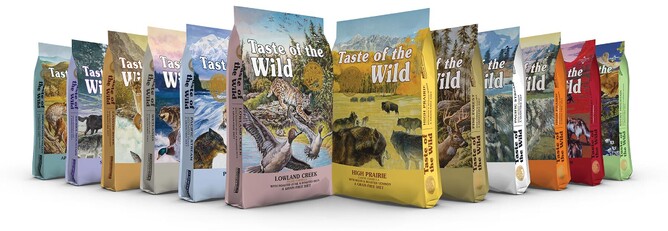How do you choose the best type of food for your dog or cat? We’ve compiled a guide that takes you through the key things to consider when choosing your pet’s food to ensure they perform at their best.
With the numerous pet food brands on the market today, it can be difficult to choose what the right diet for your dog or cat should include (or exclude!). You want to give your best friend a diet to ensure they perform at their peak and maintain great health; however, it can be confusing with the myriad of choices available today.
Here at Taste of the Wild, we have a genuine passion for providing top quality pet food that is backed by science. To give domestic dogs and cats the vitality nature intended, their pet food must contain all the ingredients and nutrition they need to thrive. And that is precisely what they get with all Taste of the Wild recipes: complete pet foods based on the protein sources from your pet’s ancestral diet.
We feel strongly that your pet’s diet should be the best it can be, so we’ve compiled some tips to simplify choosing the right pet food for your best friend:
1. Protein content
High quality protein in your pet food is crucial for peak performance. Cats are carnivores and need meat to survive and whilst dogs are omnivores and consume a variety of plant and animal sources, they also perform best on a high protein diet.
Vegetable proteins that appear in many dog food brands are often cheaper but provide a much lower nutritional value for your pet and can be more difficult to digest. When choosing pet food, look for a high proportion of meat or fish listed first on the ingredients list.
Ideally, you should look for single source, clearly specified proteins, for example “Beef” or “Chicken”. If the protein description is vague such as “meat by-product”, “meat meal”, or “animal derivatives”, the proteins used are likely to be cheaper and offer lower nutrition value for your pet.
2. Ingredient quality
Pet food ingredients are listed in weight order, and the primary protein should be the very first ingredient listed. Don’t settle for anything with ambiguous descriptions like “meat by-products”.
If you see a lot of chemicals, additives and preservatives, steer clear of the item. These low quality and artificial ingredients are cheap to manufacture, but difficult for your pet to digest so often pass through your pet’s system with minimal nutritional absorption. Several common pet allergies, skin and digestion problems are thought to be a result of poor-quality food.
While high quality, natural pet foods are more expensive at face value, they are generally more nutritionally concentrated so smaller amounts are needed. Cheap pet food may cost more in the long term due to the larger needed to provide the right amounts of nutrition for your dog or cat.
3. Wet vs dry pet food
There are pros and cons to both wet and dry pet food, but we believe it’s best to provide your pet with a varied and balanced diet so don’t be scared to use both wet and dry food and mix things up a bit – they usually enjoy the variety.
Dogs and cats have fewer taste buds than us and so food with a stronger flavour, as wet food often has, can be more attractive to them. Wet food also provides much needed hydration and is a great choice if your pet is a reluctant drinker. As pets get older, they can also lose their sense of smell, their teeth get brittle and they are less able to cope with dry food.
High quality dry food on the other hand can be more nutritionally dense, is much more convenient and tidier to feed with, keeps better and some are formulated to clean your pet’s teeth as they eat. Using both wet and dry food together can provide the best of both worlds!
4. Age-appropriateness
Your pet will need different things from their food depending on their stage of life. Kittens and puppies need high energy, protein, and fat diets for their development, and so do pregnant and nursing animals. Just like us, unless they are very active, adult pets need to watch what they eat and keep to a healthy weight and so a lower calorie diet is better. Older animals need less calories as they slow down and their need for easily digestible proteins with higher moisture content increases.
5. Understanding pet food labels
A high-quality pet food will tell you a lot about what’s in their food. The lower the quality of the food, the less information is given, so if nothing else this is a good guide of quality! Here’s how to decipher what they’re telling you.
Composition: these are the ingredients. The composition section lists in all the ingredients in descending order by weight. It allows you to check the quality of the ingredients used.
Analytical Constituents – this is the nutrient analysis of the finished product - the amount of protein the amount of fibre, fats and so on. The amount of meat listed in the Composition section does not equal the protein intake in the finished product. It’s important to check the Analytical Constituents to see the final composition of the food. Ash is often listed here, and this refers to minerals. If you were to completely incinerate the pet food, everything would burn away leaving only the food’s minerals (zinc, calcium etc). This is what is referred to as ash.
Nutritional Additives – these are generally natural vitamins and minerals that are added because they are essential to your pet’s health. However other brands include additives such as artificial flavourings, colours, and preservatives.
6. The cost of pet food
High quality natural pet food does come at a higher price than mass-produced, low-quality foods, however the ingredients are so much more nutritionally dense, so pets need much less of it in terms of quantity.
Taste of The Wild has carefully sourced high quality, all-natural pet food that we know will benefit the health of your pet, plus we ensure the price points are accessible to all dog and cat lovers who don’t want to compromise on quality.
7. Grain free or not grain free?
All grains are not created equal and whilst meat and protein should be the primary ingredient in your animal’s diet, good-quality grains shouldn’t be excluded. Dogs and cats have a limited ability to extract nutrients from non-meat sources, so we believe that the key is ensuring a high-quality protein diet, and that any grains included have excellent nutritional value with proper proportions to meat.
Grains are cheaper than meat and many low-quality pet food brands use grains such as corn and wheat as a filler to bulk their food up which will make your pet feel full but offer little or no nutritional value.
Some pet owners choose to avoid grains altogether as some pets find them difficult to digest and go on to develop a grain allergy which can lead to digestive lining damage, leaky gut, bowel inflammation, increased flatulence, pet obesity and skin irritations. Get to know your pet and what food triggers insensitivities for them.
8. Providence
Who are the people who make your pet food? Do they care about your pet, and do they care about what they make? Do they have a positive or negative impact on the environment?
When you’re buying food for your pet, do some research on the company behind the brand and you’ll soon learn whether they genuinely care for animal welfare over profits. Understand where your pet’s food comes from and whether the company that makes it has a genuine passion for animal health and considers the environment in its processes.
So, there you have it - the best rule of thumb when choosing your pet food is to treat it with a bit of common sense and apply some of the same criteria you would for your own diet by ensuring high quality protein and natural ingredients.
The Taste of the Wild range offers quality, affordable dog and cat food with protein sources based on your pet’s ancestral diet. In every formula, the first ingredient is from real meat, fish, or fowl. We use unique and flavourful proteins like wild boar, bison, smoke-flavoured salmon, roasted duck, venison, and Angus beef to make better-tasting dog and cat food that your pet will love.
See our canine formula and our feline formula for more information on our ingredients and for stockist information, complete our form and someone from our team will get back to you soon!






